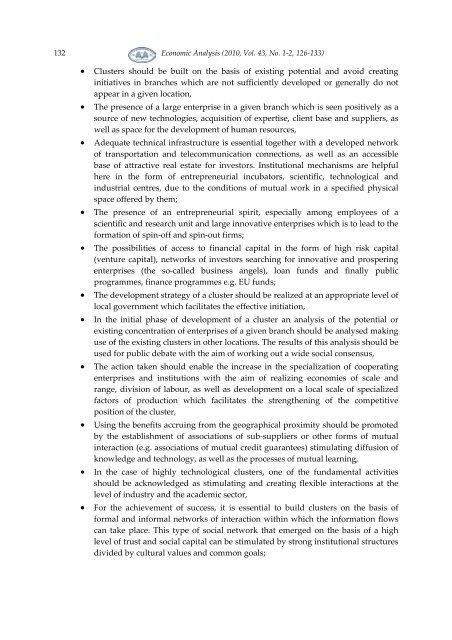Twice a Year Scientific Journal
Twice a Year Scientific Journal
Twice a Year Scientific Journal
Create successful ePaper yourself
Turn your PDF publications into a flip-book with our unique Google optimized e-Paper software.
132<br />
Economic Analysis (2010, Vol. 43, No. 1-2, 126-133)<br />
• Clusters should be built on the basis of existing potential and avoid creating<br />
initiatives in branches which are not sufficiently developed or generally do not<br />
appear in a given location,<br />
• The presence of a large enterprise in a given branch which is seen positively as a<br />
source of new technologies, acquisition of expertise, client base and suppliers, as<br />
well as space for the development of human resources,<br />
• Adequate technical infrastructure is essential together with a developed network<br />
of transportation and telecommunication connections, as well as an accessible<br />
base of attractive real estate for investors. Institutional mechanisms are helpful<br />
here in the form of entrepreneurial incubators, scientific, technological and<br />
industrial centres, due to the conditions of mutual work in a specified physical<br />
space offered by them;<br />
• The presence of an entrepreneurial spirit, especially among employees of a<br />
scientific and research unit and large innovative enterprises which is to lead to the<br />
formation of spin-off and spin-out firms;<br />
• The possibilities of access to financial capital in the form of high risk capital<br />
(venture capital), networks of investors searching for innovative and prospering<br />
enterprises (the so-called business angels), loan funds and finally public<br />
programmes, finance programmes e.g. EU funds;<br />
• The development strategy of a cluster should be realized at an appropriate level of<br />
local government which facilitates the effective initiation,<br />
• In the initial phase of development of a cluster an analysis of the potential or<br />
existing concentration of enterprises of a given branch should be analysed making<br />
use of the existing clusters in other locations. The results of this analysis should be<br />
used for public debate with the aim of working out a wide social consensus,<br />
• The action taken should enable the increase in the specialization of cooperating<br />
enterprises and institutions with the aim of realizing economies of scale and<br />
range, division of labour, as well as development on a local scale of specialized<br />
factors of production which facilitates the strengthening of the competitive<br />
position of the cluster,<br />
• Using the benefits accruing from the geographical proximity should be promoted<br />
by the establishment of associations of sub-suppliers or other forms of mutual<br />
interaction (e.g. associations of mutual credit guarantees) stimulating diffusion of<br />
knowledge and technology, as well as the processes of mutual learning,<br />
• In the case of highly technological clusters, one of the fundamental activities<br />
should be acknowledged as stimulating and creating flexible interactions at the<br />
level of industry and the academic sector,<br />
• For the achievement of success, it is essential to build clusters on the basis of<br />
formal and informal networks of interaction within which the information flows<br />
can take place. This type of social network that emerged on the basis of a high<br />
level of trust and social capital can be stimulated by strong institutional structures<br />
divided by cultural values and common goals;
















